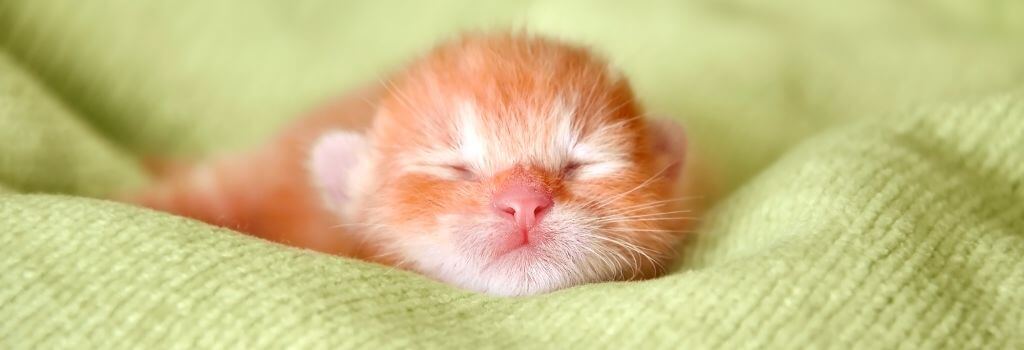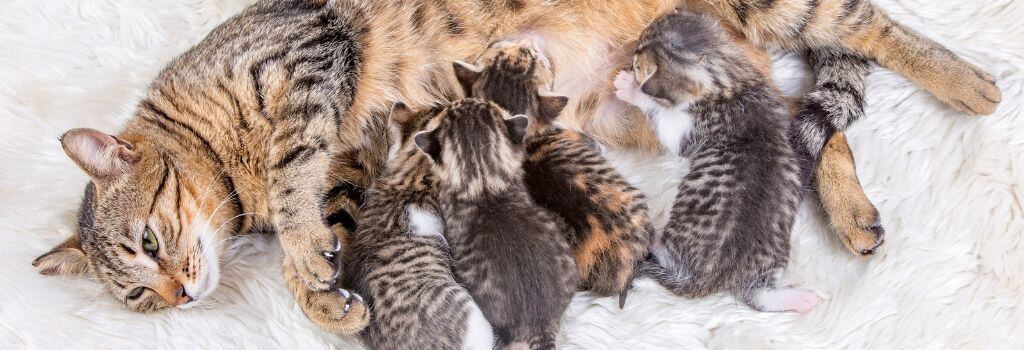A lot happens for kittens in their first few weeks of life; from opening their eyes and learning to walk, to eating solid food and getting acquainted with their litter box, the early stages of a cat’s life are quick and full of developmental milestones.
Whether you are a first-time kitten owner or an experienced cat parent, understanding the stages of kitten development is crucial for cat owners to give their kittens the proper nutrition, healthcare, and enrichment necessary for a healthy and well-adjusted life. This week-by-week guide outlines key milestones in kitten development, from neonatal growth and early socialization to the transition into adulthood.
Kitten Development Timeline
Birth to 2 Weeks: Neonatal Stage
The first life stage is neonatal, a short period after the kitten’s birth lasting only two weeks. Over this time frame their eyes will start to open so they rely more on sound and smell to interact with their surroundings.
A kitten’s eyes should be open by the time they are two weeks old. Their interactions with their siblings and mother help to mold their understanding of a social hierarchy. They are fully dependent on their mother for nutrition, warmth, and hygiene. Weaning at this stage can lead to an adult cat that has a hard time interacting with people and other animals. They should be gaining weight, ultimately doubling their birth weight by two weeks of age. Their immune system is also completely reliant on the passive transfer of antibodies from their mother through colostrum.

2 to 4 Weeks: Transitional Stage
The next life stage is two to four weeks of age and is known as the transitional stage. During this period the kittens will start to become mobile and will crawl around their environment as their senses are developing and allowing them to interact with more than just their mother and littermates.
They will start to develop baby teeth that allow them to begin to interact through play with their litter mates and mother to learn the appropriate use of their teeth, biting hurts. While the kitten will be showing noticeable signs of growth during this stage, they are still very reliant on their mother for hygiene, nutrition, and warmth. Their immune system is still heavily reliant on the ingestion of colostrum when they are firstborn.
4 to 8 Weeks: Socialization Stage
The next life stage is four to eight weeks old, the socialization stage. This is a crucial stage where the kittens become much less reliant on their mother. By the end of this stage, they will be able to live without any help from their mother.
In this stage of socialization, kittens should be playful and interact with their littermates through play and competition to develop natural bonds and learn about living within a social structure. They will start to learn hunting behaviors and should start to groom themselves.
The immunity given to them from their mother’s colostrum is waning and they will need to start vaccinations to help prevent them from getting diseases such as panleukopenia.
8 to 12 Weeks: Early Kitten Stage
The next stage is the early kitten stage from 8 to 12 weeks of age. This is when kittens become their most fun. They are incredibly active and playful. They will be learning all sorts of social interactions as their motor skills start to become more coordinated. It is very important that as they are leaving their littermates and mother they have a ton of enrichment by the owner to promote normal mental health.
Vaccinations should continue every 3 weeks during this stage.
3 to 6 Months: Junior Kitten Stage
The next stage of kitten development is ages three to six months. This is the junior kitten stage where kittens start to lose their baby teeth – by six months of age all adult teeth should be present.
The kittens will start to develop their daily routines and a stable enriched home will allow them to continue to properly develop their social skills. The kittens will continue to become more curious and mobile. It is important that as they become more mobile we match their environments to allow them to have places that are safe and fun to explore. Adding a perch by a window or on walls will allow a cat to gain elevation, which many cats love.
6 to 12 Months: Adolescent Stage
The final stage of kittenhood is 6 to 12 months – which can also extend up to 18 months in some kittens – adolescence. This is when sexual maturity if not spayed or neutered will occur. This coincides with an increased need for exploration and dominance. This may lead to challenging their human owners. This is why spaying and neutering before this age leads to happier adult cats with less negative behaviors that decrease the human-animal bond and may lead to a cat being relinquished.
These kittens will start to look more and more like an adult cat. It is important at this life stage to start daily at-home dental care as cats only have one set of adult teeth. Starting this care at a young age will make it more easily accepted and keep dental care as a prophylactic procedure and not reactive to dental disease.
Spaying and Neutering Considerations
We recommend cat spaying and neutering procedures at four to six months of age. This allows the kittens to be a little larger and less likely to experience hypothermia during their surgery.
This will be before their first heat cycle/sexual maturity and prevent them from developing unwanted territorial behaviors such as redirected aggression and urine marking. This also prevents them from breeding and adding potentially unwanted pregnancies to the world. It also may save a cat from trauma as many in-heat cats or sexually mature male cats near an in-heat cat will slip outside of the home and travel across streets. This also will typically keep a male cat from going out and getting into a cat fight with another male cat, leading to the spread of diseases like FIV and abscesses.
12 Months and Beyond: Adulthood
After 12 to 18 months of age, the kittens will be considered adult cats. Their personality and behaviors typically stabilize at this time.
If at a healthy weight, they are typically 8 to 10 pounds. Obesity is a very common health problem and is typically due to decreased activity of indoor cats and eating more than 200kcal per day. These kittens should be transitioned to adult cat food.
Keeping an Eye on Kitten Growth Milestones & Helping Your Kitten Adjust to Their New Life
Nutrition
Nutrition is a crucial aspect of kitten development, and as a kitten rapidly grows, its diet and how it gets the majority of its nutrients will change, too. Assuming a kitten is still with the mother cat, it would be unusual for the mother cat to not feed the kittens correctly, so pet owners don’t need to worry too much about nutrition in the early stages of a kitten’s development. However, there are some circumstances where an owner will need to step in and supply the kitten with appropriate nutrition. For example, if the kitten were to be orphaned, they would initially require bottle feeding and then would need to be switched to solid food at the appropriate age.

I typically recommend that owners start introducing solid food at four weeks of age. At this age, kittens will learn what their food is, as well as how to eat it, by essentially playing with it. I encourage cat owners to start with canned pate kitten food and place it in a confined space where the kittens are allowed to make a mess of it – the kittens will then groom it off their fur or try a bite due to their natural curiosity, ultimately, letting them learn to eat solid food. Owners can also put a bowl of water in this area for them to explore, too. After the first week or so with pate food, owners can take the same approach with dry food or kibble. The kittens should take the solid food quickly, and usually, within a couple of weeks, they are weaned and completely on solid food.
After a kitten has been transitioned to a solid food the owner should focus on purchasing a diet that is AAFCO approved for the kitten life stage – the labeling on the bag will let you know. The labels on the diets are accurate for kittens and if followed, will prevent under feeding and malnutrition.
Proper nutrition most often becomes skewed after a kitten is spayed or neutered. At that time, most kittens experience a slowing of their metabolism and an increase in appetite that is secondary to neutering and spaying. This leads to many cats becoming obese. The goal would be for the average adult cat to eat 200 kcal per day and weigh 8 to 10 pounds.
Exercise, Play, and Enrichment
Younger cats will have quite a bit of energy, so make sure to carve time out of your day to play with them and give them plenty of enrichment. Owners should be sure to provide a scratching area that allows them to stretch out entirely when they are adult cats – many cat scratching areas are too small and will not work past kittenhood, so plan ahead and give your cat a space they can grow into. Keeping a kitten or young cat entertained and giving them an outlet for normal scratching behaviors will do a lot to save your furniture and your sanity in the long run.
Enrichment is another important aspect of caring for a cat and aiding proper development that can be overlooked by many pet owners. Indoor cats need enrichment to prevent boredom, reduce stress, and support their physical and mental well-being. Without stimulation, they may develop behavioral issues like excessive meowing or destructive scratching. Interactive toys, tall climbing structures, and puzzles are all great options to keep cats mentally stimulated and entertained. A number of veterinary-approved resources, like Ohio State’s Indoor Pet Initiative website can provide great tips and tricks for feline enrichment.
Grooming
While it’s true that cats are pretty self-sufficient when it comes to grooming, there are a few aspects of grooming that owners will need to help out with – and trust us, the sooner you start the better! Getting your cat used to actions like nail trimming, brushing, and ear cleaning at an early age can make things less stressful for both of you later on.
Start to work early with positive reinforcement with treats for necessary grooming tasks like nail trimming, and take things slow when first starting. Owners shouldn’t feel like they need to trim every single nail in one go, things can be spread out based on how well your cat is tolerating the grooming. To make things easier, you can use human toenail clippers and Churu treats to carefully clip one or two toenails at a time, allowing the kitten to adjust to nail trimmings over time.
Regular Veterinary Care for Kittens
Welcoming a new kitten into the family and watching it reach various developmental milestones can be incredibly exciting, but ensuring they receive proper veterinary care is essential for their long-term health. Healthcare milestones every kitten should complete in their first year typically include:
Kitten Vaccination Schedule
Kittens need a series of four vaccine visits, starting at six weeks of age and continuing every three weeks until they reach 15 weeks old. These vaccinations protect against serious diseases and help build a strong immune system.
Spaying or Neutering
As discussed above, by six months of age kittens should undergo a spay or neuter procedure. Before surgery, a complete health assessment is performed, including a CBC, chemistry panel, and blood clotting tests to ensure they are safe for anesthesia.
Parasite Prevention & Fecal Testing
Heartworm and parasite prevention should begin at eight weeks of age and continue year-round to protect against heartworms, intestinal parasites, fleas, and other pests.
Fecal testing is performed twice in the early months to check for gastrointestinal parasites, as some parasites intermittently shed eggs, making false negatives possible. The first test is at the six-week visit, and the second is at the nine-week visit. If both tests are clear, routine fecal exams are then performed every six months, unless symptoms suggest a need for additional testing.
Continuing Veterinary Care for Adult and Senior Cats
As your cat reaches adulthood and continues to age, regular veterinary care should become a non-negotiable part of your care routine. Annual wellness check ups and keeping on top of preventive care, like dental care and flea and tick prevention, will go a long way in keeping your cat healthy and allowing them to spend as many happy years with you as possible.
If you have questions and you'd like to reach out to us, you can call us directly at (912) 525-0255, or you can email us at [email protected]. Don't forget to follow us on social media Facebook, Instagram.

